 |
||
|
||
| ||
Part 2 |
|
Tweet | ||
|
Tweet | ||

Spring... It's time to awake from the winter hibernation... And NVIDIA, like a she-bear with its bear-cubs, goes out with its GeForce babies...
But why MX440? Why not the junior MX420? First of all, the MX440 is quite cheap in production and its price is already lower than that of GeForce2 Ti cards. Secondly, the MX420 has a strict upper limit, that is why it won't be possible to skim the cream off in the beginning by making the prices high. You know the MX440 is selling now at $100-110, and in the nearest time the price will fall down below $100, and the MX420 will have to be priced at, at most, $70 (retail!). As you remember, the GeForce2 MX cost $150-170 in the very beginning when the GeForce2 GTS had unbelievably high prices; that is why the MX420 won't be popular with manufacturers. I think the MX420 will be mainly produced by noname companies using the base from the MX400, the memory is the same, it is only the chip which is different. Thirdly, production of MX460 cards will be expensive because of 3.6ns memory (in a BGA package), and the price of GeForce3 Ti200 have dropped to $150-180 being very close to the MX440. You see that it's quite a problem for a new product to get into such a narrow price range. Besides, MX460 is not a good substitute for the GeForce3 Ti200 cards. You can find out here why.
That is why the MX440 cards are first to come out into the market: they got a definite niche to occupy and they got what to replace - GeForce2 GTS/Pro/Ti. The MX420 is meant to replace the MX400, but it seems that the manufacturers do not want to set such low prices as $50-70. But it's only what I think.
Theoretical materials and reviews of video cards which concern functional properties of the NVIDIA GeForce4 MX GPU
In our first part we examined 4 video cards which were first to appear on the market. Today we are going to take a look at 4 more cards on the GeForce4 MX 440 which are also production models.
All cards have an AGP x2/x4 interface, 64 MBytes DDR SDRAM located in 4 chips on both sides of the PCB.
| Inno3D Tornado GeForce4 MX440 | |
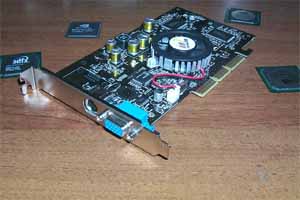 |
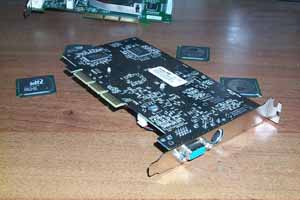 |
| Sparkle GeForce4 MX440 | |
 |
 |
| Palit Daytona GeForce4 MX440 | |
 |
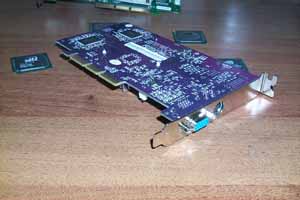 |
| Gainward PowerPack GeForce4 MX440 Golden Sample | |
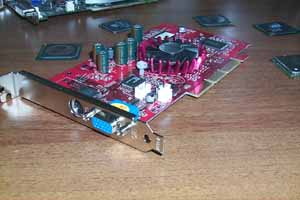 |
 |
| Inno3D Tornado GeForce4 MX440 | |
| Samsung 4ns memory chips. The card operates at 270/200 (400) MHz. |  |
| Sparkle GeForce4 MX440 | |
| Samsung 4ns memory chips. The card operates at 270/200 (400) MHz. | 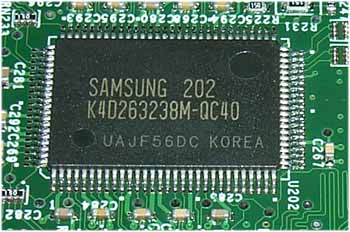 |
| Palit Daytona GeForce4 MX440 | |
| Samsung 5ns memory chips. The card operates at 270/200 (400) MHz. |  |
| Gainward PowerPack GeForce4 MX440 Golden Sample | |
| Samsung 4ns memory chips. The card operates at 290/200 (400) MHz in a usual mode and at 290/220 (440) MHz in the extreme one. |  |
All card except the Palit Daytona GeForce4 MX 440 come with 4ns memory which means that the memory is potentially able to work at 250 (500) MHz.
Besides, all cards follow the reference design. They differ only in color and coolers. Keep in mind that the GeForce4 MX 440 doesn't need much cooling (for example, ASUSTeK equip its cards only with a passive pin heatsink).
The developers don't place the second VGA connector, though there is a seat for it. It's strange because there is everything to active the dual-head support. I have two ideas: either there are problems in the GeForce4 MX440 chip or it's the marketing step (probably, they are going to release the second revision with the second head but at a higher price).
All the cards have TV-out (realized by the GPU), and almost all have an S-Video-to-RCA adapter.
Now about what accessories the cards have:
All cards ship in the retail package (apart from the Palit, which is available both in the retail package and in the OEM one, though the set of accessories is the same).
As far as TV-out is concerned, see the previous material.
| Inno3D Tornado GeForce4 MX440 | 270/400 -> 305/460 MHz |
| Sparkle GeForce4 MX440 | 270/400 -> 305/470 MHz |
| Palit Daytona GeForce4 MX440 | 270/400 -> 290/460 MHz |
| Gainward PowerPack GeForce4 MX440 Golden Sample | 290/440 -> 310/470 MHz |
The 4ns memory doesn't help much the overclocking. Even at 250 (500) MHz (the rated frequency) some artifacts could be noticed. The overclocking of the GPU is not much beneficial either.
Note:

Testbed:
The test system was coupled with ViewSonic P810 (21") and ViewSonic P817 (21") monitors.
In the tests we used NVIDIA's drivers of v27.30. VSync was off, S3TC was off.
For the comparative analyses we used the following cards:
The 2D quality is very high of all cards, and you can work comfortably at 1600x1200x75 Hz and 1280x1024x100 Hz. But you must have a high-quality monitor and use connection via BNC. Besides, 2D quality much depends on a sample of the card and on its friendliness towards a monitor.
For estimation of 3D quality we used:
We use few tests because there is our 3Digest where we compare a lot of cards in a great deal of tests. And this time we just compare several production cards.
The tests were carried out in a 32-bit color mode.

Look how good the RADEON 7500 performs when three texture units for a pixel pipeline are activated. Although the graphics is complicated this card is a leader in high resolutions. The GeForce2 Ti is an outsider. We see again that the GeForce4 MX 440 is en excellent substitute for the aging GeForce2.
The tests were carried out in 32-bit color mode at the highest detailing and quality level of textures.

Now the leader is the GeForce4 MX 440. And the RADEON 7500 falls behind.
The GeForce4 MX has a new engine of MPEG2 flow decoding. Unfortunately, there are no DVD players able to work with this engine. NVIDIA is going to release its NVDVD model soon:
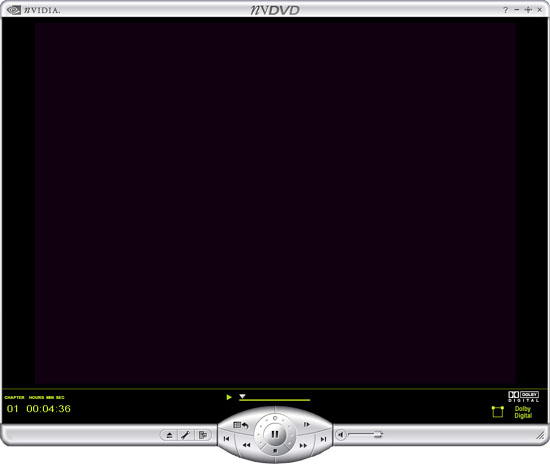
We used its beta version to check operability of the new processor.
The CPU utilization when the NVDVD worked on the GeForce4 MX 440 was jumping from 5% to 20%. Usual players (PowerDVD 4.0, WinDVD 3.2) are not able to work with the GeForce4 MX normally.
We examined today 4 production video cards based on the GeForce4 MX 440. On the whole, I must say that such an accelerator is a very strong competitor against the ATI RADEON 7500 and a killer of the GeForce2 Ti. The common drawback is lack of the DVI.
Besides, in some cards the BIOS is incompatible with some drivers of v27.* in the Windows 9x. The monitor displays just snow and strips. You can cure it by flashing the new BIOS.
The complete characteristics of video cards of this and other classes can be found in our 3Digest.
Write a comment below. No registration needed!
|
Article navigation: |
| blog comments powered by Disqus |
| Most Popular Reviews | More RSS |
 |
Comparing old, cheap solutions from AMD with new, budget offerings from Intel.
February 1, 2013 · Processor Roundups |
 |
Inno3D GeForce GTX 670 iChill, Inno3D GeForce GTX 660 Ti Graphics Cards A couple of mid-range adapters with original cooling systems.
January 30, 2013 · Video cards: NVIDIA GPUs |
 |
Creative Sound Blaster X-Fi Surround 5.1 An external X-Fi solution in tests.
September 9, 2008 · Sound Cards |
 |
The first worthwhile Piledriver CPU.
September 11, 2012 · Processors: AMD |
 |
Consumed Power, Energy Consumption: Ivy Bridge vs. Sandy Bridge Trying out the new method.
September 18, 2012 · Processors: Intel |
| Latest Reviews | More RSS |
 |
Retested all graphics cards with the new drivers.
Oct 18, 2013 · 3Digests
|
 |
Added new benchmarks: BioShock Infinite and Metro: Last Light.
Sep 06, 2013 · 3Digests
|
 |
Added the test results of NVIDIA GeForce GTX 760 and AMD Radeon HD 7730.
Aug 05, 2013 · 3Digests
|
 |
Gainward GeForce GTX 650 Ti BOOST 2GB Golden Sample Graphics Card An excellent hybrid of GeForce GTX 650 Ti and GeForce GTX 660.
Jun 24, 2013 · Video cards: NVIDIA GPUs
|
 |
Added the test results of NVIDIA GeForce GTX 770/780.
Jun 03, 2013 · 3Digests
|
| Latest News | More RSS |
Platform · Video · Multimedia · Mobile · Other || About us & Privacy policy · Twitter · Facebook
Copyright © Byrds Research & Publishing, Ltd., 1997–2011. All rights reserved.